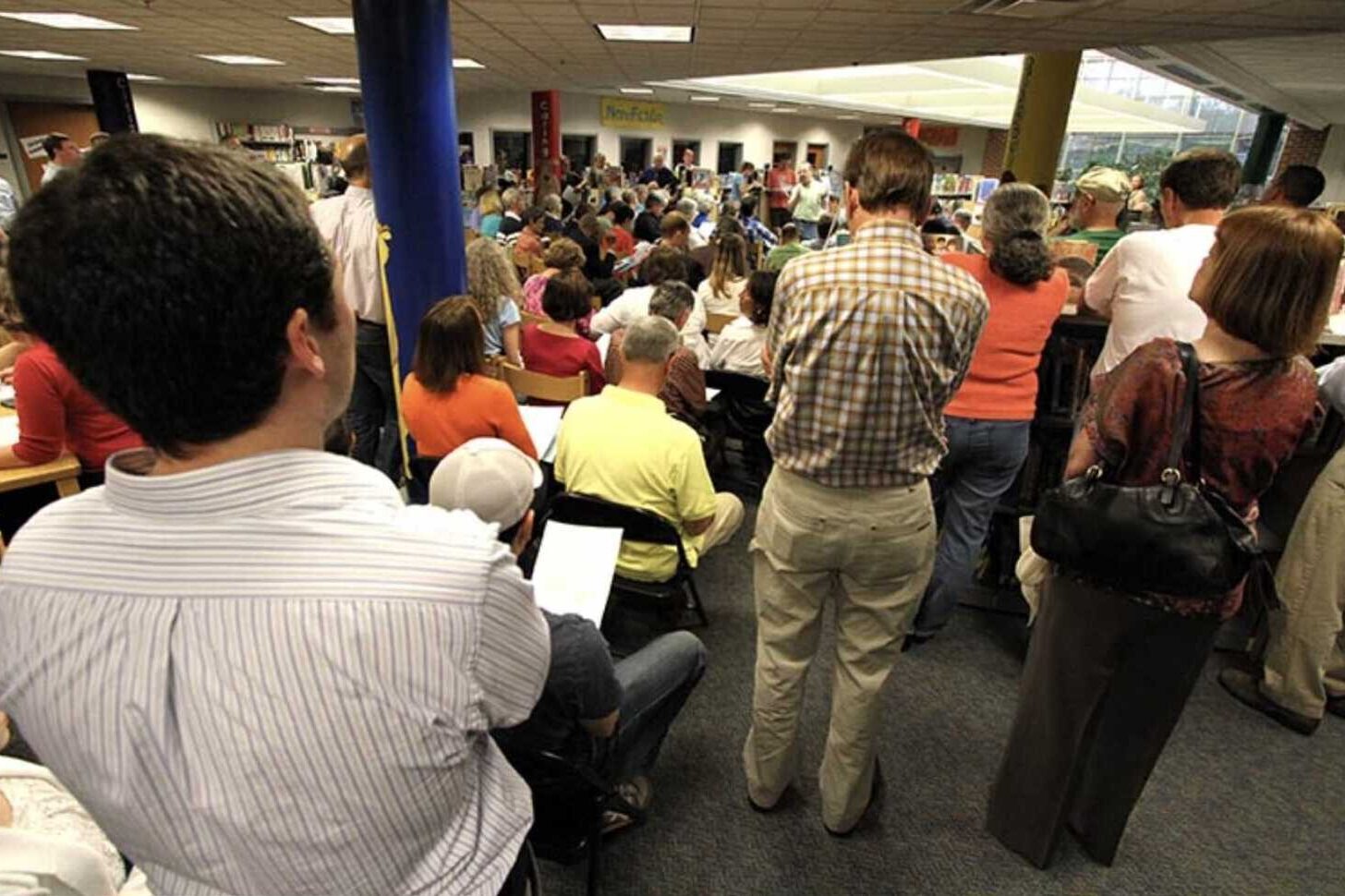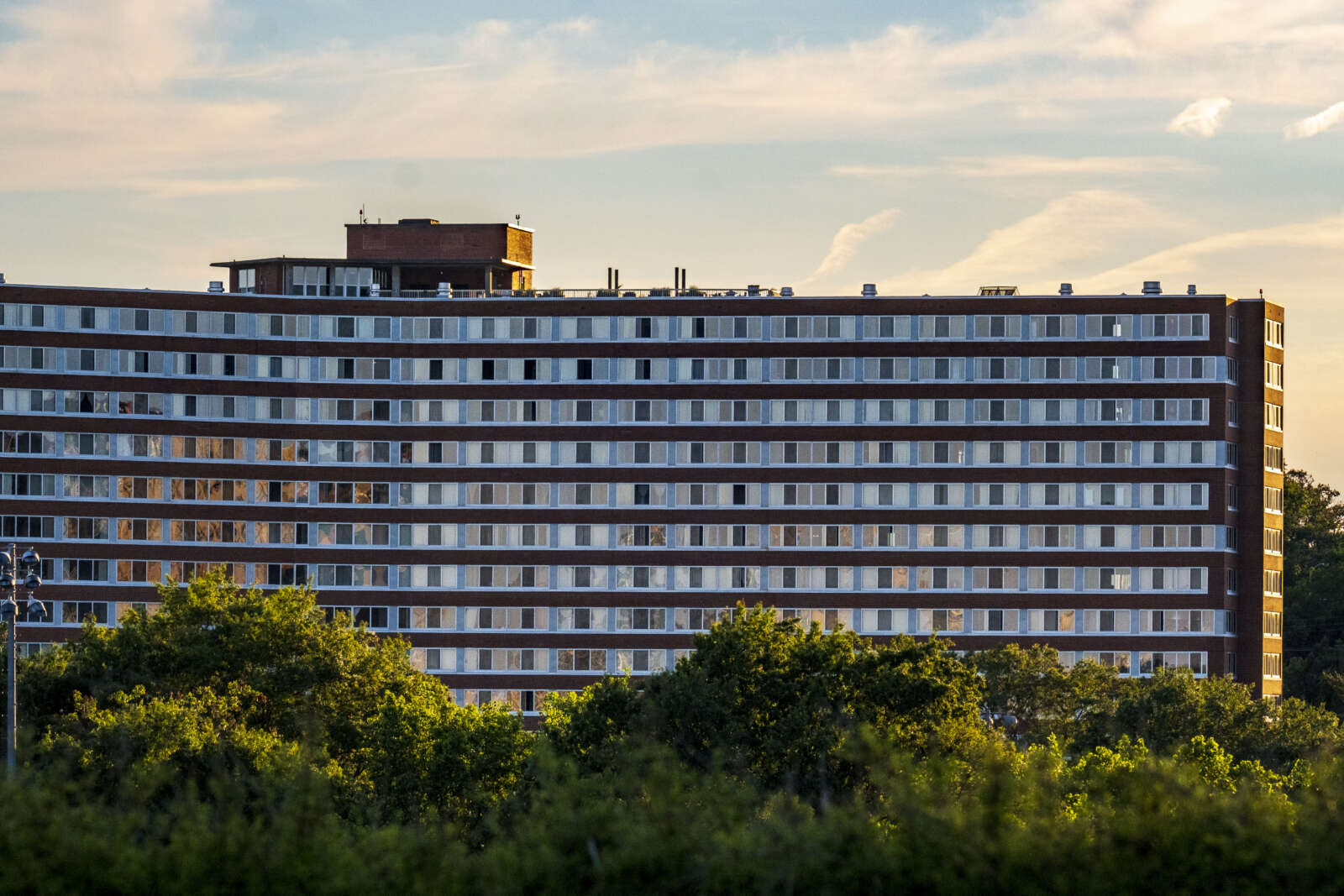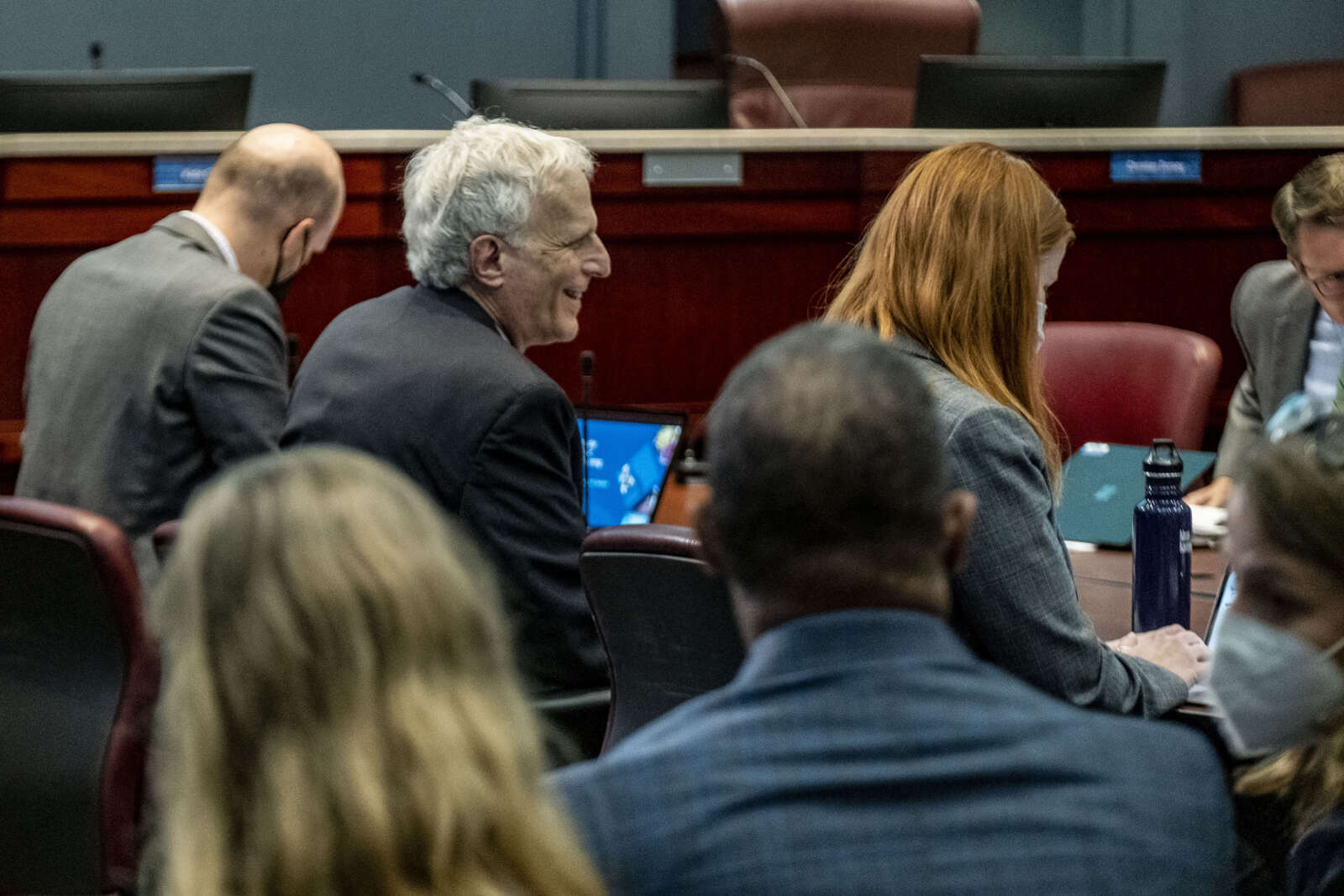
This reporting was supported by the ARLnow Press Club. Join today to support in-depth local journalism — and get an exclusive morning preview of each day’s planned coverage.
Three years into his tenure as Penrose Neighborhood Association president, Alex Sakes can proudly say he got a grocery store to corral its shopping carts roaming Columbia Pike.
After much lobbying on his part, the grocer committed to installing GPS security locks on its carts, ending a 10-year, multi-neighborhood problem.
His other chief accomplishment is ongoing: updating how the civic association runs so it attracts more young people like Sakes, 27, who may be Arlington’s youngest association president. An early step in this process was to redesign the website.
“It was a big success that drove a lot of members to sign up and formally join our association,” said Sakes, who admits that, ironically, the website was down at the time of our interview, while he switches the domain.
Live Zoom meetings are later posted on YouTube, a pandemic-era pivot that stuck. There is an active association Facebook group. Sakes wants to organize more informal social gatherings to build the community outside of monthly meetings, with their updates on graffiti, retail vacancies, developments and yes, shopping carts.
Arlington institutions — including some 55 civic associations, their umbrella group the Arlington County Civic Federation, and the Arlington Committee of 100 — are pushing 70-100 years old. They began in an era when the Rotary Club relied on men using their lunch hour to attend meetings and Parent-Teacher Associations recruited from ranks of stay-at-home moms.
The world looks different today, muses County Board Chair Libby Garvey.
“Those organizations arose to meet the need and social structure then, but they’re still here and they don’t fit so well,” she said. “How do they fit 21st-century needs and schedules?”
Leaders acknowledge their membership ranks skew toward older homeowners but their long-term survival depends on attracting younger people. The Committee of 100 is rethinking its events and forging new partnerships to diversify its ranks. Civic associations are having to change their outreach methods and bylaws to reach apartment dwellers while CivFed is reexamining its advocacy efforts to be more effective and a better sell to potential members.
“If you join CivFed, there’s a good chance that you’ll find, in our member organizations, a number of others who feel the same way you do about issue X,” says CivFed President John Ford. “There is strength in numbers.”
Garvey sees in civic institutions another strength in numbers: community resiliency, which she is championing during her County Board victory lap this year. Should these organizations fade away, she worries the parades and pancake breakfasts, block parties and yard sales will follow.
“Civic associations are important for building community,” she said.

Acknowledging the issue and finding its root
Hannah Dannenfelser was 21 when she got involved in Arlington Jaycees, a volunteer organization for young professionals. It was not long before she was recruited by a youngish Committee of 100 board member to join the board.
“There’s a lot of enthusiasm, conceptually, for getting young professionals involved but… sometimes, a lack of understanding of what makes a Millennial feel like they belong at the table,” she said. “People just need to feel like someone they know or someone they respect is engaged. Most people just need an actual hand extended to them.”
Aside from urging members to search their contacts for recruits, the Committee of 100 swapped its $30 pre-panel dinners with $10 social hours with drinks and appetizers and, for its program on regional women’s health inequities, partnered with the National Coalition of 100 Black Women and a historically Black sorority.
Both changes brought in a younger, more diverse audience, says Dannenfelser. Covid-era virtual meetings — easier for younger working professionals, especially parents, to attend — grew the organization’s email list from 250 people to north of 1,600 people.
“When people think about civic engagement, they’re intimidated by the time commitment,” she said. “We’re in Arlington… You have people in this area [who]… have an expectation of efficiency. I think that’s why virtual is working — because virtual meets that expectation of efficiency.”
Online meetings get people’s foot in the door but well-promoted in-person events keep them involved, says Todd Truitt, the chair of the CivFed schools committee.
“It’s really about threading that needle,” he said.
The deeper issue, he says, is that young people care more about national politics than local school issues and county elections. He recalls hitting the gym the day after Commonwealth’s Attorney Parisa Dehghani-Tafti bested her primary challenger, Josh Katcher, and Maureen Coffey and Susan Cunningham outlasted four candidates in Arlington’s first ranked-choice voting test.
“I talked to two people in their 30s — one of whom is a surgeon, the other has a master’s degree and wears political shirts to the gym all the time,” he said. “I asked them, ‘Oh, did you guys vote in the primary yesterday? And the answer was, ‘Oh, what primary?'”
These civic institutions, however, do not just have to overcome a lack of awareness. Sometimes, their own structures get in the way.

Engaging renters
Cathie Seebauer remembers her interest in joining the Arlington Ridge Civic Association cooling when she read the bylaws.
She and some 57% of Arlington Ridge residents would have to apply for regular membership — which comes with voting rights — because she did not own property.
“[The bylaws] also say, ‘A bi-monthly print newsletter is delivered to all residents’ in the community,’ yet it isn’t sent to apartments,” she said. “Showed me immediately that they didn’t actually want renters to participate. If they fixed those types of things, renters would be much more involved.”
Resident Joe James, who dove into civic life and housing advocacy for about a year before burning out, says it is not always this explicit. Sometimes, he says, renters perceive these groups not putting in much effort to reach them.
Arlington Ridge Civic Association President Kateri Garcia says ARCA is amending its bylaws so the executive board does not have to approve renters, recognizing the process can be a barrier to participation, even though every renter who applied in her tenure has been approved.
As for outreach, several civic association leaders say tapping renters is hard because they cannot get inside apartment buildings to hand-deliver newsletters like they would to single-family homes.
“We have had better luck engaging with the condo buildings recently by working through the condo associations, but still have challenges reaching all the members somewhere like RiverHouse,” Garcia said. She added that one renter from the large apartment complex in Pentagon City is active on a council for the Crystal City and Pentagon City neighborhoods and brings valuable input.
CivFed has faced similar criticisms. Truitt credits past president Allan Gajadhar for trying to change this in part by reinstating the schools committee and bringing in younger parents. Ford notes some apartment building associations joined the organization this past year.
“We’re not where we want to be,” Ford said. “We want to offer a welcome and a reason for joining to everybody.”
ARLnow talked to residents who said the county could have a role in bridging the civic association-renter divide. It could require, via apartment development applications, that property managers grant civic associations access for engagement purposes. It could make email distribution lists available to civic associations. It could set inclusion standards, pushing associations to ensure the homeowner-renter split in membership reflects the neighborhood.
The county says these ideas might open doors to privacy issues and fairness questions or create more burdens for already-pressed volunteer organizations. To reach renters, the county stood up a multifamily complex directory, which it recommends civic association leaders use. (This was also a CivFed invention: former Vice President Nicole Merlene says she suggested this years ago and, while it was being developed, made and circulated her own.)
“We have the same challenges as civic associations getting through the front door and the way we’ve been approaching it is to start building relationships with [property owners],” says Assistant County Manager and Director of Communications and Public Engagement Bryna Helfer. “The National Landing Business Improvement District has bought property managers and the civic associations together to introduce each other.”
Dweck Properties President and Chief Development Officer Andy Van Horn tells ARLnow that Dweck has distributed Crystal City Civic Association newsletters via email and on bulletin boards and let the group man tables in its lobbies. This arrangement is borne of connections he forged with the three National Landing-area civic associations while at JBG Smith, when the company was taking over Vornado properties in 2017.
“Given Dweck’s apartment footprint is the largest in National Landing, it made sense that we could use our scale and unique culture of care to find win-win outcomes with the community,” he said.
Improving the efficacy of these organizations
Not every civic association has it together, however. Ford says some have an active board, a regular newsletter and issue-specific committees while others struggle to assemble six people for a meeting.
“I think our job is to offer, as an umbrella organization, a convening place [and] member services,” he said. CivFed’s ranks now include people with some web expertise, and other popular requests are for newsletter content and advice on bylaws.
Sakes says the county could provide support the way that Arlington Economic Development helps small businesses. He considers it a small investment given how much staff solicit feedback from these groups for county and private projects. Helfer counters that this work falls to CivFed, with which the county works closely.
One positive step could be the return of pre-Covid round tables with civic leaders, County Manager Mark Schwartz and other county brass, on unifying topics such as speeding or flooding. Ford says the response to one-off round tables earlier this year was so strong more will be held in May.
While civic associations focus on neighborhood-specific issues, CivFed attracts locals with higher-level interests in the budget and transparency, though its track record as a conduit of these shared concerns is mixed.
For instance, its resolution for greater county transparency — in response to clashes with the county over Freedom of Information Act requests — devolved to infighting over thinly veiled criticisms of the Missing Middle zoning ordinances, which were the source of many transparency complaints.
James, the renter and one-time urbanism advocate, says this was a function of who’s at the table.
“[Renter exclusion] filters out moderate voices and the voices of those who speak against the civic association status quo, further polarizing these civic groups to be more unreasonable in their rhetoric and more hostile to those who disagree with them,” he said.

Getting Arlington County to respond
While modernizing is the means of survival, the end goals are still building community and getting results on issues residents care about.
“There’s so much burnout,” says Sakes, thinking back to emails in the Penrose Neighborhood Association inbox from 2007-08, advocating for attention to issues similar to what residents face today.
Parents of elementary and middle school-aged children used existing schools and county channels to call for wider sidewalks on S. Carlin Springs but these have not materialized because of easement issues. The county is trying to improve safety in Green Valley but residents say this came only after they showed the Board they exhausted other options: community education, meetings with county staff, the creation of a spin-off safety group and countless letters and emails.
“At the end of the day, things move forward and sometimes they don’t, for different reasons, but I would say that everything is taken seriously when it comes to the county,” says Helfer. “Sometimes it doesn’t happen at the pace people want because of the budget, or other resources, or other competing factors.”
The X user behind the Advanced Towing Fire Hydrant account, for instance, maintains that the account does more than document the towing company’s alleged parking violations. Pointing to emails from county officials disgruntled with the social account, @AdvancedTowingFireHydrant has told ARLnow the goal is to show the disconnect between residents who surface issues and county leadership — while calling for a more responsive government.
🤬🕵️♀️😤"the Fire Department is understandably tired of being harassed by a citizen and social media about the Advance Towing tow truck parking in front of our hydrant with no repercussions." 🤯🤯🤯 @ArlingtonDES @ArlingtonVA pic.twitter.com/vLlD5AOFGk
— Advanced Towing Fire Hydrant (@AdvTowHydrant) January 29, 2024
Though transparency is a concern, Ford says he believes the bigger issue is that the county is overwhelmed. That makes it less likely that individual outreach will move the needle, policy-wise.
“If you want to influence the Manager and the Board, your best path forward is to craft a consensus among directly affected groups, whoever they are,” he said.
By way of example, he said Cardinal Elementary School has stormwater retention vaults underneath it today in part because CivFed helped unify four associations, a school PTA and other groups concerned about stormwater — the type of coalition building he wants more of going forward.
“We’re trying to move to a different model, if you will, that focuses on knitting organizations together around common interests,” said Ford. “They don’t have to become grievances. They are, most of the time, naturally, but they’re also common projects for the good of the whole.”

